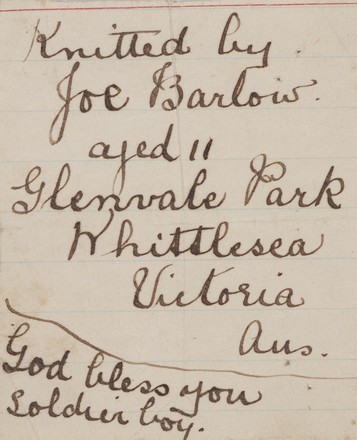One of the few small comforts for a digger in unfamiliar territory during the First World War was to receive a pair of hand-knitted socks from a stranger back home.
It meant he was not forgotten.
But how much better if the socks turned out to contain a brief but touching message of support. Even young boys were prepared to pick up the knitting needles in support of the war effort.
"Knitted by Joe Barlow aged 11 Glenvale Park Victoria God bless you soldier boy," one message said.
'Wishing you all a quick victory and a speedy return," wrote Bill O'Brien from the Shand Hotel in Newport, Victoria.
Maurice John "Jack" Pickrell was the recipient of these and more notes which go on show on Tuesday, along with his other papers, at the Amaze Gallery at the State Library of NSW. An image of Pickrell also features in the Remember Me: the Lost Diggers of Vignacourt exhibition, which is also being held at the State Library.
The library believes that there are many similar notes lying undiscovered.
Pickrell also received notes from a Maud Schafer from Willaura, Victoria, and a Miss Dorothy Smith from Cudal, NSW.
It is believed more than 1 million pairs of socks were knitted by Australian women and children during the war. The Australian Comforts Fund co-ordinated knitting circles and the delivery of much needed socks to the troops. Predominantly run by women, the fund provided and distributed free "comforts" to the Australian troops including tobacco, chocolate, newspapers and cakes.
Pickrell was born in Sussex, England, in 1894 and arrived in Australia about 1910, aged 16. In 1914, he was employed as a driver for a doctor in Glen Innes and enjoyed some success as a golfer. He drove a horse and buggy for the doctor and transported him on all his house calls.
While in Brisbane visiting an aunt, he walked into a recruitment office on September 18, 1914, and walked out an enlisted soldier in the A.I.F. at the age of 20. It would be more than four years before he returned to Glen Innes and met, at the golf club, the woman he would marry.
His skills as a driver came in useful as a deliverer of essential stores to the troops in Egypt, Gallipoli and northern France.
Serving in the 4th Divisional Transport, he told a story of horses and men bathing in the ocean prior to Gallipoli. He also recalled holding the horses and trying to keep them calm in northern France during shelling.
His son, Tony Pickrell, 77, who lives in North Rocks, said he believed the socks would have been well received on the Western Front with harsh winter conditions.
"I think to get a pair of socks they would have been only too happy. I have his diary and he apparently was a good letter writer. Every third day or so he seemed to be sending a postcard off to someone or other," he said.
"When he was on leave, he took the trouble to write back to the girls. I didn't get this stuff and papers until 1998. By then, these people would be gone. Had I known about them earlier, I might have tried to contact them."
Driver Pickrell died at the age of 75.



 Back to list
Back to list